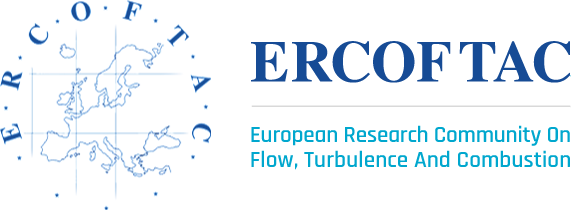ERCOFTAC PC Belgium
Simulation of Wake-Blade Interactions in a High-Speed Low-Pressure Turbine Cascade
Using a High Order Discontinuous Galerkin Method
Mars Thys, Nathan Deneffe
(Aerospace & Mechanics Department, Université de Liège (ULiège), Belgium)
Maxime Borbouse
(Aerospace & Mechanics Department, Université de Liège, Belgium; von Karman Institute for Fluid Dynamics, Belgium)
Margaux Boxho, Michel Rasquin
(Centre de Recherche en Aéronautique (Cenaero), Belgium)
Sergio Lavagnoli, Gustavo Lopes
(von Karman Institute for Fluid Dynamics, Belgium)
Koen Hillewaert
(Aerospace & Mechanics Department, Université de Liège, Belgium; Centre de Recherche en Aéronautique (Cenaero), Belgium;
von Karman Institute for Fluid Dynamics, Belgium)
Numerical Schlieren visualization of a Direct Numerical Simulation (DNS), using ArgoDG, the discontinuous Galerkin solver of Cenaero. The simulation replicates a wake-blade interaction experiment on the SPLEEN high-speed low pressure turbine cascade performed at VKI, in the high subsonic (M=0.7) low Reynolds regime (Re=70k). The interaction of acoustic waves generated by the cylinder wakes with the boundary layer of the blade is visible. The wake generator exhibits a complex flow, featuring a relatively strong oscillating shock attached to an almost steady base flow. The shock interacts both with the wake to which it is attached and with the wake shed by the upstream neighbouring cylinder, leading to wake displacement, fine scale diffraction of the outer shock regions and modulation of turbulence in the wakes.
Scientific Abstract
Direct Numerical Simulations (DNS) are undertaken with a high-order discontinuous Galerkin code to reproduce experimental studies of flow phenomena in high-speed/transonic low-pressure turbine cascades, performed during the Horizon2020 project “Spleen”. The flow regime under study is of primary importance in improving the performance of the new generation of civil aircraft engines and in particular the geared turbofan and the unducted fan configurations. The DNS campaign aims at improving the interpretation of the experimental results and the understanding of compressibility effects on transition and wake development. It involves a parametric study covering two Reynolds numbers (Re2s=70.000 and 120.000), three Mach numbers ranging from high subsonic to choked conditions (M2s = 0.7, 0.9, 0.95), varying levels of inlet turbulence intensity (clean and 5% TI) and wake-blade interactions.
The animation shows first a (numerical) schlieren visualization and entropy of the DNS of the wake-blade interaction experiments in the high subsonic low Reynolds regime. The setup includes a wake generator composed of moving cylinders placed upstream of the linear blade cascade.
The interaction between the upstream-propagating short-wavelength acoustic waves emanating from the wake of the turbine blade, and the boundary layer on the suction side is clearly visible, as expected in this high-subsonic regime. The wake generated by the wake generator is advected in the passage and deformed by the velocity gradients.
In addition to these expected results, the simulation reveals an important and less anticipated challenge in reproducing experimental wake-blade interaction at high Mach number. The flow around the wake generator accelerates to a significant Mach number (around 2), leading to the formation of a moderately strong shock. This shock remains attached to the base flow and interacts strongly with both the base flow and the cylinder wake, resulting in a slowly oscillating and breathing motion. Moreover, the shock extends all the way to the neighbouring wake and slightly deflects it. The interaction of the shock with the strong turbulence in both wakes induces considerable shock diffraction, and significantly alter the turbulent flow in the wake, an effect that was not accounted for during the design of the experimental setup.
References:
Lopes, G.; Simonassi, L.; Gendebien, S.; Torre, A. F. M.; Patinios, M.; Zeller, N.; Pintat, L.; Lavagnoli, S. An Open Test Case for High-Speed Low-Pressure Turbines: The SPLEEN C1 Cascade. International Journal of Turbomachinery, Propulsion and Power 2025, 10 (1), 2. https://doi.org/10.3390/ijtpp10010002.
Simonassi, L.; Lopes, G.; Lavagnoli, S. Effects of Periodic Incoming Wakes on the Aerodynamics of a High-Speed Low-Pressure Turbine Cascade. International Journal of Turbomachinery, Propulsion and Power 2023, 8 (3), 35. https://doi.org/10.3390/ijtpp8030035.
Lopes, G.; Simonassi, L.; Lavagnoli, S. Impact of Unsteady Wakes on the Secondary Flows of a High-Speed Low-Pressure Turbine Cascade. International Journal of Turbomachinery, Propulsion and Power 2023, 8 (4), 36. https://doi.org/10.3390/ijtpp8040036.
Lavagnoli, S., Lopes, G., Simonassi, L., and Torre, A. F. M., 2023, “SPLEEN High Speed Turbine Cascade – Test Case Database,” https://doi.org/10.5281/zenodo.7264761
Borbouse, M.; Lopes, G.; Lavagnoli, S.; Rasquin, M.; and Hillewaert, K. “Analysis of Separation and Transition on a Novel High-Speed Low Pressure Turbine Cascade.” In Proceedings of the Cambridge Unsteady Flow Symposium 2024, 341–62. https://link.springer.com/chapter/10.1007/978-3-031-69035-8_21.
Borbouse, M.; Deneffe, N.; Thys, M.; Boxho, M.; Lopes, G.; Lavagnoli, S.; Rasquin, M.; and Hillewaert, K. “Direct Numerical Simulations of the SPLEEN cascade: a study of the impact of compressibility on transition and separation in a low-pressure turbine passage.” In Proceedings of the 16th European Turbomachinery Conference 2025.
Acknowledgments:
The simulations have been performed using ArgoDG, the discontinuous Galerkin solver developed at Cenaero. The present research benefited from computational resources made available on Lucia, the Tier-1 supercomputer of the Walloon Region, infrastructure funded by the Walloon Region under the grant agreement n°1910247. These computational resources have been provided through the computational allocation “turbodns” on the Lucia cluster at Cenaero by the Consortium des Équipements de Calcul Intensif (CÉCI), funded by the Fonds de la Recherche Scientifique de Belgique (F.R.S.-FNRS) under Grant No. 2.5020.11 and by the Walloon Region.
